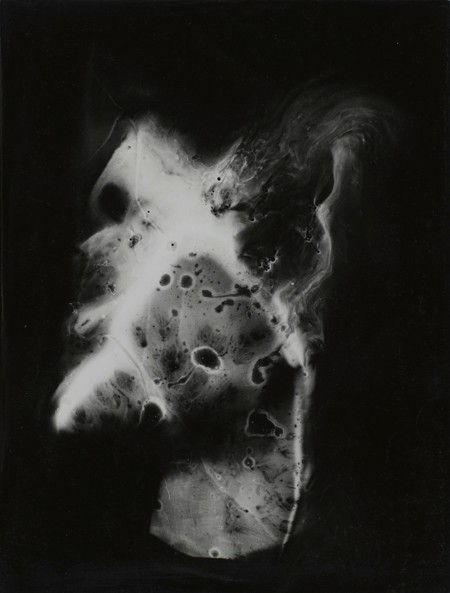At the onset of World War II, Raoul Ubac (1910–1985) did a surprising thing: he started burning his glass-plate negatives, heating the emulsion until the image began to decompose. Introducing violence into his process through what he termed an “automatism of destruction,” in these so-called brûlage photographs the artist attacked representations of isolated objects and figures, negating the capacity of the photographic matrix to reproduce its original referents. Almost an oily abstraction, L’Envers de la face (1939) offers the fugitive form of a head seen in profile, all features liquidated, providing only the barest anchors for the possibility of recognition. Ubac’s procedural interventions were explicitly tied to his desire to transfigure human anatomy: “Indeed nothing can seem as abject as the immediate appearance of the human face,” he wrote in 1942. The face, but also photography itself, posed significant problems for Ubac. The destructive intervention of brûlage is only the most extreme of a welter of technical devices by which he endeavored to depersonalize the figure and deconstruct the medium. But he hoped that such an image could provide the matrix for subsequent states in a sequence of transformative figurations.
My dissertation takes up Ubac’s confrontation with photography in the 1930s and through World War II. Born in Germany, raised in Belgium, and trained in Cologne amid the Gruppe progressiver Künstler, Ubac came of age as an artist in Paris, operating as a key relay between French and Belgian surrealist circles. His photographs were similarly itinerant. My project tracks these images and their variants as fragments and distinct states in serial transformations, as they moved from the pages of art reviews and photography annuals, cropping up in semiclandestine journals of the Occupation, following the networks of the burgeoning domain of modern art photography and surrealism’s increasingly international ambitions. In their migrations, Ubac’s photographs unveil a filigreed map of connections from Brussels and Paris, alighting in publications and galleries in Cologne, Amsterdam, London, Prague, Cairo, Mexico City, and New York.
The majority of Ubac’s photographic oeuvre de-centers the camera to privilege the darkroom, so that the procedures linking the photographic matrix (usually the negative) to print provide opportunities for experimentation and transformation. My dissertation looks in depth at four technical procedures used by Ubac: photomontage, solarization, paraglyph simulations of bas-reliefs and fossils, and brûlage. Each of these techniques is representative of tendencies in experimental, commercial, and amateur photographic practices of the 1930s. And each process pressures the normative technical operations by which a conventional photographic image is transmitted from camera exposure to development of the negative to the output of a positive print. This technical framework enables me to probe in detail an artist’s oeuvre that has evaded thorough attention within the existing scholarship on surrealism and the history of photography as well as to reflect on the conditions that have produced that historiographic lacuna.
Ubac’s elaboration of modernist photographic processes offers a distinctive approach to reproduction and transmission, in part informed by his study of printmaking at Stanley William Hayter’s Atelier 17. Unlike the majority of interwar photomonteurs, Ubac worked with photographs that he had staged for the camera with an eye to subsequent recombination. Moreover, many of his pictures depict works of art, transmuting the photographic capture of the real human body and found objects into sculptural assemblages. In exhibitions he displayed multiple “states” of a given pictorial composition, demonstrating the work of transformation and transmission within photographic chains of reproduction: solarized and unsolarized versions of identical compositions appear side by side; motifs move from photomontage to engraving. The artist courted resemblance to and produced simulations of other media, which he absorbed and “processed” photographically in his works. In a perceptive essay on Ubac’s photography published in Cairo in 1940, the Egyptian writer Georges Henein reported that Ubac was loath to call his pictures photographs at all. On the one hand they demonstrate a consistent engagement with major tropes of surrealist pictorial production, but they also metabolize the competing claims for monumental art in disparate instantiations ranging from Pablo Picasso’s Guernica (1937) to fascist appropriations of classicism.
Ubac’s contestation of photographic media is inextricable from his
registration of contemporary political crises. His anthropological interest in the origins of law, the persistence of the sacred within modernity, and the imbrications of violence and desire are developed in the motifs he adopts; these concerns were particularly pressing with the contemporaneous advance of fascism and the collapse of the French Popular Front in the late 1930s, reaching a breaking point with the advent of war and the German occupation. The clamor of politics bangs incessantly at the door of the atelier; the photographer’s darkroom is leaky. The noise of the present finds a way in, under the cracks, through the vents. Flashes of the contemporary interfere with the photograph in development, troubling the reproductive fidelity of the technical apparatus. Ubac’s is a flight out of photography using the very procedures of the photographic.
